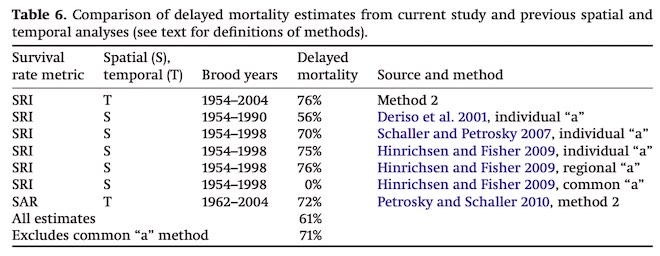forum
library
tutorial
contact

Why are Salmon and Steelhead
on the Path to Extinction?
by Yancy Lind
Bend Bulletin, December 8, 2020
|
the film forum library tutorial contact |

|
Why are Salmon and Steelhead
by Yancy Lind
|
 The Bulletin recently published an article from the Associated Press titled "Study: Ocean conditions, not dams, reduced salmon runs" This is misleading reporting of the original study, "A synthesis of the coast‐wide decline in survival of West Coast Chinook Salmon" published in the Fish and Fisheries journal.
The Bulletin recently published an article from the Associated Press titled "Study: Ocean conditions, not dams, reduced salmon runs" This is misleading reporting of the original study, "A synthesis of the coast‐wide decline in survival of West Coast Chinook Salmon" published in the Fish and Fisheries journal.
The research study argues that the most prized salmon and steelhead populations along the west coast of North America are in decline, often dramatically so, and that the reasons are complex. Dams are not the sole culprit. This can be a controversial statement in many environmental circles, but it is true. It is well known that anadromous fish are declining in river systems that are not impacted by dams as well as where dams are present. This is not an either-or proposition, however.
There are many factors contributing to the decline of these fish and dams are certainly one of them. Other reasons include poor water quality from various sources of pollution, habitat degradation and loss, lower river levels due to agricultural and municipal consumption, excessive harvest, higher water temperatures, breeding between wild fish and stray, genetically inferior hatchery fish, etc.
In the Columbia River, dams have created a series of slow moving, hot lakes that are lethal to returning salmon and steelhead. These lakes also confuse and slow down juvenile fish heading out to the ocean, further weaken them with exposure to high concentrations of parasites, and contain predators like Northern Pike Minnow and invasive species like bass.
Closer to home, while some passage has recently been provided, for decades local dams have stopped fish from spawning in the waters they historically called home. Lake Billy Chinook is another artificial reservoir that impedes out migrating smolts and returning adults.
Agricultural runoff and other sources of pollution have fouled local waters creating a toxic stew for salmon, steelhead, as well as resident fish such as trout and bull trout. Ever wonder what happens to all the ground down toxic bits of tire that comes off our cars? It is dispersed into the environment where we breath, eat, and drink it. We now know that a chemical in this tire dust also kills salmon.
One of the most important issues for all anadromous fish today, however, is our rapidly heating planet. Dramatically rising ocean temperatures have disrupted the ocean’s food web. The juvenile steelhead and salmon that can make it to the ocean find little to eat and often starve to death. Of course, they are not the only ocean species suffering from a lack of food. At the other end of food web, the plight of starving Orcas in Puget Sound has been widely reported.
This is the point of the research report. Even fish who call relatively pristine rivers home are precipitously declining in numbers due to degraded ocean conditions. As the report points out, scientists have predicted this for nearly two decades. Little has been done with this knowledge, however, and today "rebuilding targets may be unachievable" everywhere, regardless of the presence or lack of dams.
To quote the research paper, "At the broadest level, the major implication of our results is that most of the salmon conservation problem is determined in the ocean by common processes. Attempts to improve SARs [smolt to adult return rates] by addressing region‐specific issues such as freshwater habitat degradation or salmon aquaculture in coastal zones are therefore unlikely to be successful."
Global heating is why the slow but steady decline in salmon and steelhead has turned into a calamitous drop in recent years. Without dramatic change, and soon, anadromous fish are on the road to extinction. Of course, fish are not the only living organisms that will suffer from our rapidly heating planet.
Related Pages:
A synthesis of the coast-wide decline in survival of West Coast Chinook Salmon by David Welch, Aswea Porter, Erin Rechisky, Fish and Fisheries, September 17, 2020
learn more on topics covered in the film
see the video
read the script
learn the songs
discussion forum
